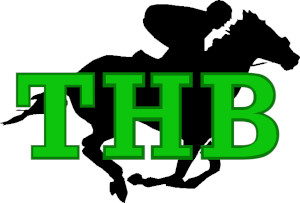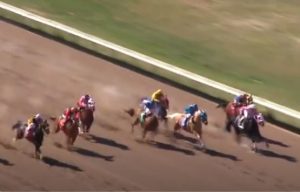Quarter Horses race over distances of 1/2 mile or less. These races are usually run on dirt tracks. Quarter horse races are the shortest horse races and are usually run at a full sprint.
What Are Quarter Horse Races?
Quarter Horse races are a specific type of horse racing in which the horses run a distance of between 220 yards (1/8 mile) and 880 yards (1/2 mile). The traditional and most popular race distance is 440 yards (1/4 mile.)
Quarter Horse races are popular in the United States, with many tracks across the country hosting hundreds of races per year.
The Quarter Horse was bred specifically for its strength and speed. They are very powerful and fast sprinters, and they can accelerate quickly from a standing start up to 55 miles per hour in a very short time. This is much faster than both Thoroughbreds and Arabians.
Quarter Horse races are standard times, which means that they have a fixed start time and a set finish time. They also have a set distance and track surface. Reference: horse racing standard times.
How Do Quarter Horse Races Work?
Quarter horse races are sprints, with a typical distances of a quarter of a mile (440 yards or 2 furlongs), 220 yards (1/8 mile or 1 furlong), or 870 yards (1/2 mile or 4 furlongs). They are the shortest of the horse races, and are run on a straight, flat course.
Quarter Horse races are run counter-clockwise, and the horses line up at a starting gate. This is similar to Thoroughbred racing.
The horses are assigned starting positions in the gate based on their post position draw. The horse with the number one post position will start from the inside rail, while the horse with the number eight post position will start from the outside rail.
The gates may be staggered to ensure the horse on the outside rail does not have to run farther than the horse on the inside rail.
The jockeys wait for a red light to turn to green or starter’s pistol to be fired to indicate the start of the race. When the race starts the horses bolt out of the gates and sprint for the entire distance from start to finish at full tilt. The first horse to cross the finish line wins the race.
Quarter Horse races are typically run with eight horses on the track at once. There are also 4-horse races and 12-horse races, but these are not as common.
While Quarter Horse races do not have the same long history and popularity as Thoroughbred racing, they have grown to become popular mainstream entertainment in North America. There are hundreds of Quarter Horse tracks across the United States, and many of these tracks offer live wagering, simulcast betting, and other forms of gambling. Many people enjoy betting on Quarter Horse races, and there is always a lot of excitement surrounding these events.
Quarter Horse Racing History
Quarter Horse racing is thought to have originated in the American colonies in the 18th century. The horses were used for racing, but also for other activities such as working on farms and plantations.
The name “Quarter Horse” is thought to come from the fact that these horses were able to sprint a quarter mile very quickly.
Quarter Horse racing became more organized in the early 20th century, with the first official race taking place in 1916.
The American Quarter Horse Association (AQHA) was founded in 1940, and today Quarter Horse racing is a popular sport across the U.S., Canada and Mexico.
Quarter Horse Track Sizes
A Quarter Horse race track is generally a dirt oval track ranging between 220 yards (1/8 mile or 1 furlong) and 870 yards (1/2 mile).
440 yards (1/4 mile) — hence the “Quarter Horse” name — is the traditional length.
- Short sprints include 220, 250, 300, 330 and 350 yards. 220 yards is 1/8 mile (1 furlong).
- Long sprints include 400, 440, 550 and 660 yards. 440 yards is 1/4 mile (2 furlongs).
- Around the Hook races cover 770 or 870 yards, and use a portion of a turn. 870 yards is 1/2 mile (4 furlongs), which is the official limit for Quarter Horse races.
There are also some Quarter Horse racing tracks that are turf courses. Turf is more popular in Europe than it is in North America.
The Quarter Horse Jockey
The jockey is an important part of any successful Quarter Horse race. Quarter horses are built for speed, and their short, muscular legs are designed for short sprints rather than long-distance running.
Because they are shorter in stature than Thoroughbreds, quarter horses require a different riding style than their longer-legged counterparts. Quarter horse jockeys must be able to maintain a low center of gravity and keep their weight as close to the horse’s withers (shoulder area) as possible. This allows the horse to maintain its top speed for the duration of the race.
In addition to being skilled riders, Quarter Horse jockeys must also be knowledgeable about the specific physical and psychological needs of the breed. Quarter Horses require different conditioning than Thorougbreds and must be properly cared for in order to perform at their best on race day.
Jockeys must work closely with trainers and veterinarians to ensure that their horses are healthy and fit enough to compete.
Betting on Quarter Horse Races
Payouts in quarter horse racing are usually based on a system known as pari-mutuel wagering. This system allows bettors to pool their money together and then receive payouts based on the total amount of money bet on each horse. The more money that’s bet on a particular horse, the bigger the payoff will be if that horse wins the race.
The usual bets available in Thoroughbred races also apply to Quarter Horse races.
FAQs About Quarter Horse Races
Do They Still Race Quarter Horses?
Yes. Quarter Horse racing is very popular in North America, with races held all over the U.S., Mexico and Canada. There hundreds events sanctioned today, with 11 lengths ranging from 220 to 870 yards (201 to 796 meters).
Which Is Faster? Quarter Horse or Thoroughbred?
Quarter horses are faster over short distances than Thoroughbreds. The maximum speed of a Quarter Horse is 55 mph, while the fastest Thoroughbred was “Winning Brew” who ran 43.97 mph. Quarter Horses run faster for short distances. However, the longer gait and stamina of Thoroughbreds allows them to run faster over long distances past 1/2 mile.
Can a Quarter Horse run in the Kentucky Derby?
No. Due to the Kentucky Derby’s exclusivity to the top three-year-old Thoroughbreds, quarter horses are not permitted to compete.
Who Was the Fastest Quarter Horse Ever?
The fastest Quarter Horse in a quarter mile race was 4-year-old First Moonflash who ran 20.274 in 2009 at Sunland Park, NM.
The next fastest Quarter Horse was Long Goodbye, who ran it in 20.686 seconds at Sunland Park, NM in 2005.
Two-year-old colt Eyesa Special ran the third fastest quarter-mile race for a Quarter Horse in 21.097 seconds at Ruidoso Downs, NM in September, 2000.
How fast do Quarter Horses run?
The American Quarter Horse top speed is 55 mph in short bursts.
Conclusion
Quarter horse racing originated in the United States and has become very popular across the U.S., Canada and Mexico. Quarter horses are usually shorter and faster than Thoroughbreds, which makes them more suited for shorter sprint races.
Related Tags
- quarter horse race lengths
- racing quarter horses
- quarter horse racing distance
- running quarter horse breed

I am Lawrence (aka “The Horse Better”). I spent 20+ years in financial risk management where I ran large-scale statistical betting models in complex situations. I grew up around horses and I’ve been betting on horse races for about 10 years with good success. I hope my articles provide good value!

